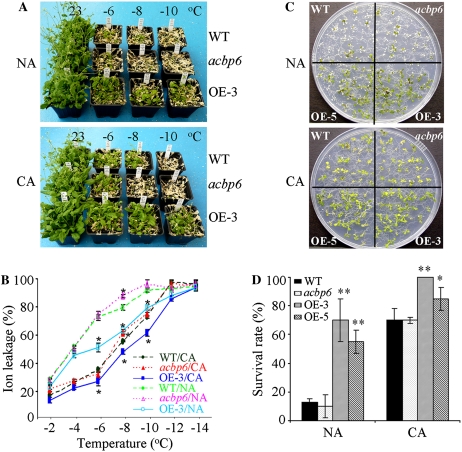Figure 4.
ACBP6 overexpressors show enhanced freezing tolerance. A, Freezing tolerance of ACBP6 overexpressor (OE-3) plants tested at different temperatures below freezing. NA and CA wild-type (WT), acbp6 mutant, and ACBP6 overexpressor (OE-3) plants were photographed after 7 d of recovery under 16-h-light (23°C)/8-h-dark (21°C) cycles. A similar phenotype was observed with another ACBP6 overexpressor line (OE-5; data not shown). B, Electrolyte leakage of NA and CA wild-type, acbp6 mutant, and ACBP6 overexpressor (OE-3) plants after 1 h of treatment at temperatures below freezing, followed by thawing at 4°C overnight. For cold acclimation, plants were incubated at 4°C for 3 d. NA plants remained in a growth chamber at 23°C until measurement. Asterisks indicate significant differences from the wild type (P < 0.05). Values are means ± sd (n = 3) calculated from three independent experiments. C, Phenotypes of NA and CA 11-d-old wild-type, acbp6 mutant, and ACBP6 overexpressor (OE-3 and OE-5) seedlings after freezing treatment at −12°C for 1 h. Plates were thawed overnight at 4°C and transferred to a growth chamber (16-h-light [23°C]/8-h-dark [21°C] photoperiods) for a 7-d recovery before photography. D, Survival rate of NA and CA wild-type, acbp6 mutant, and ACBP6 overexpressor (OE-3 and OE-5) seedlings after freezing treatment at −12°C for 1 h, followed by growth at 23°C for 7 d. Asterisks indicate significant differences from the wild type (** P < 0.01, * P < 0.05). Values are means ± sd (n = 3) calculated from three independent experiments.

